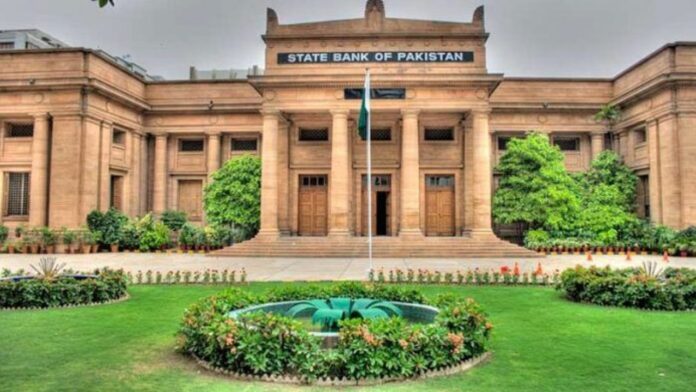KARACHI: The Monetary Policy Committee (MPC) at the State Bank of Pakistan (SBP) has decided to hike the policy rate by 125 basis points bringing it to 15 percent, the highest since 1999.
The discount rate is now 16 percent, the highest since July 1998.
In addition to hiking the policy rate, the SBP announced that the interest rates on EFS and LTFF loans are now being linked to the policy rate to strengthen monetary policy transmission.
The SBP states that this is being done while continuing to incentivize exports by presently offering a discount of 500 basis points relative to the policy rate. This means the rate offered would be 10% based on the current policy rate. At the start of 2022 EFS rate was 3%, while LTFF was at 5%
Taking these moves in mind, the SBP is continuing with the tightening cycle underway since September 2021. The SBP claims that this is aimed at ensuring a soft landing of the economy amid an “exceptionally challenging and uncertain global environment.”
The MPC also announced that going forward it will remain data-dependent, paying particularly close attention to month-on-month inflation, the evolution of inflation expectations and global commodity prices, as well as developments on the fiscal and external fronts. This has been a demand of the IMF since March 2021.
Why hike?
“I think this is an IMF-directed decision,” says Fahad Rauf, Head of Research at Ismail Iqbal Securities. He adds, “SBP has probably gone a little bit far with tightening looking at past numbers on different industries. These numbers will be very different in the coming months. The impact of fiscal measures (reversal in energy subsidies) is yet to be reflected in economic indicators.”
Rauf adds that there is no forward guidance in the statement. According to him, this implies that the SBP wants to keep the option open for a further hike.
Tahir Abbas, Head of Research at Arif Habib Limited says that the SBP acted prudently keeping in mind the expected inflation due to energy and food prices, alongside fiscal adjustments,
Through this contractionary policy, the SBP aims to cool economic activity, prevent the de-anchoring of inflation expectations, and provide support to the Rupee in the wake of multi-year high inflation and record imports.
The SBP called the reversal of the “unsustainable” energy subsidy package an encouraging development. The statement also noted that the FY23 budget was centered on strong fiscal consolidation. “This has paved the way for the competition of the on-going review by the IMF program, which will ensure that rail risks associated with meeting Pakistan’s external financing needs are averted.”
The SBP also stressed the importance of the completion of the ongoing IMF review. It said if completed, it will “catalyze important additional funding from external sources that will ensure that Pakistan’s external financing needs during FY23 are met. Pressures on the Rupee should then attenuate and SBP’s FX reserves should gradually resume their previous upward trajectory during the course of FY23.”
The SBP explained that the FX reserves had been diminishing since January due to current account pressures, external debt repayments, and paucity of fresh foreign inflows. The $.23 billion commercial loan from China helped provide support to the FX reserves.
The statement noted that economic activity has remained robust. “with the momentum of the last two years of near 6 percent growth carrying into the start of FY23. As a result, Pakistan faces a significantly lower trade-off between growth and inflation than many countries where the post-Covid recovery has not been as vigorous.”
In the eyes of the MPC, the positive news of the growth rates Pakistan has been able to achieve has been overshadowed by several adverse developments such as global inflation being at a multi-decade high in most countries.
The SBP anticipates this growth rate to moderate to 3-4 percent in FY23, on the back of monetary tightening and fiscal consolidation, helping to close the positive output gap and diminish demand-side pressures on inflation. “This will pave the way for higher growth on a more sustainable basis.”
The MPC states that headline inflation is likely to remain elevated around current levels for much of FY23. It believes that inflation will fall “sharply” to the 5-7 percent target range by the end of FY24.
SBP says time for others to do more
The SBP points out monetary tightening steps taken by other central banks across the world, especially in emerging market countries. “This strong monetary tightening has occurred despite concerns about a slowdown in global growth and even recession risks, highlighting the primacy that central banks are placing on containing inflation at this juncture”
Domestically, as energy subsidies were reversed, both headline and core inflation increased significantly in June, rising to a 14-year high. The FX reserves took a hit and the rupee remained under pressure as the current account deficit unexpectedly spiked in May and the trade deficit continued its post-March widening trend to reach a 7-month high in June; primarily due to energy imports. The depreciating rupee, however, further worsened the inflation outlook.
Non-energy imports have continued to moderate in the last three months on the back of curtailment measures by the government and the SBP. Despite that, the decline has been more than offset by the significant increase in energy imports, which rose from a low of $1.4 billion in February to an estimated record high of $3.7 billion in June.
This is not entirely due to higher prices, but instead higher volumes of petrol added pressure.
While not in the mandate of the SBP, it provided various methods to curtail energy imports.
“…for instance through early closure of markets, reduced electricity use by residential and commercial customers, and greater encouragement of work from home and car pooling”
The MPC noted that without such measures containing the trade deficit could become challenging.
However, if such measures are undertaken, “the current account deficit is projected to narrow to around 3 percent of GDP as imports moderate with cooling growth, while exports and remittances remain relatively resilient.”
“It is critical that the envisaged fiscal consolidation is delivered. It would allow monetary and fiscal policy to resume the well-coordinated approach that characterized Pakistan’s successful Covid response in FY20 and FY21, which supported growth while preserving fiscal and external buffers”
The SBP stressed the importance of the new taxation measures being progressive.
“In particular, their burden should mainly be absorbed by the relatively better off while adequate protection is provided to the more vulnerable, for whom high food prices are a particular concern. In this context, curbing food inflation through supply-side measures aimed at boosting output and resolving supply-chain bottlenecks should be high priority”
Runway inflation is a concern?
The statement further comments on the income shock to individuals as a result of high inflation due to “necessary but difficult increases in utility prices and taxes”.
The MPC notes that without decisive macroeconomic adjustments, there is a significant risk of substantially worse outcomes that would compromise price stability, financial stability, and growth.
“This could take the form of runaway inflation, FX reserve depletion, and the need for sudden and aggressive tightening actions later that would be significantly more disruptive for economic activity and employment,” warned the statement.
The MPC states that headline inflation is likely to remain elevated around current levels for much of FY23. It believes that inflation will fall “sharply” to 5-7 percent target range by the end of FY24. The decline in the inflation rate will be driven by “tight policies, normalization of global commodity prices, and beneficial base effects.”
The SBP acknowledges that adjustment is difficult but necessary in Pakistan, as it is all over the world.
Unlike itself, the MPC talks about fiscal consolidation and equitable impact absorption. The statement reads, “However, in the interest of social stability, the burden of this adjustment must be shared equitably across the population, by ensuring that the relatively well-off absorb most of the increase in utility prices and taxes while well-targeted and adequate assistance is provided to the more vulnerable”

























Nice article about monetary policy